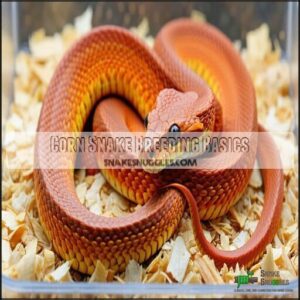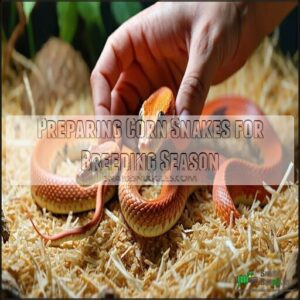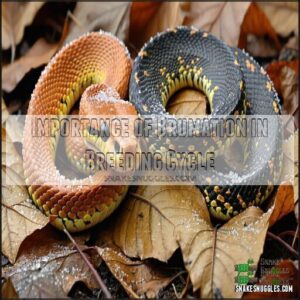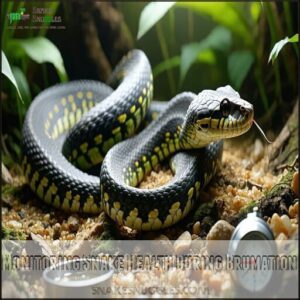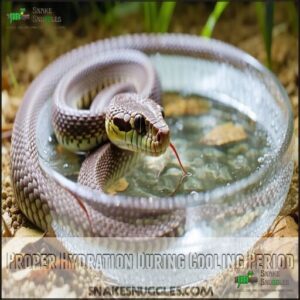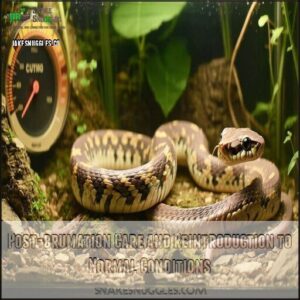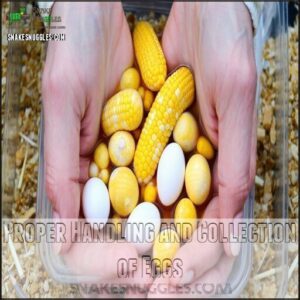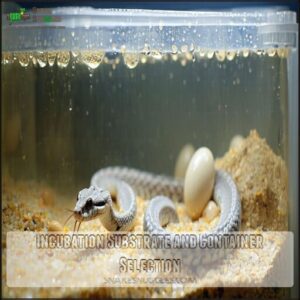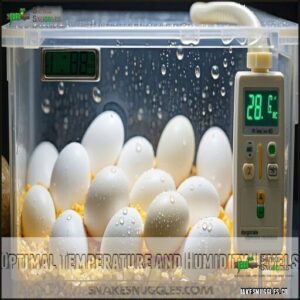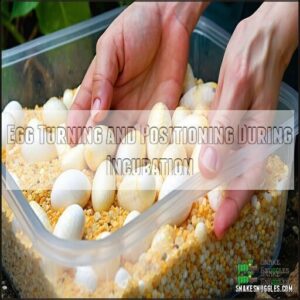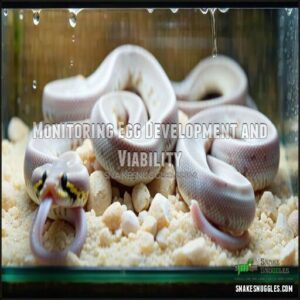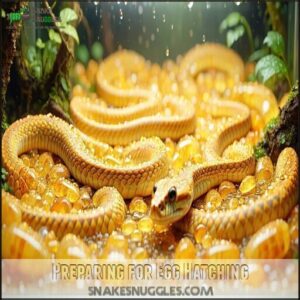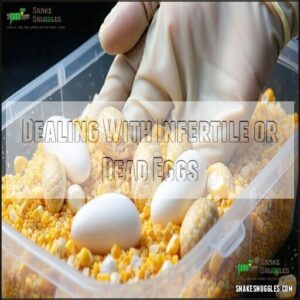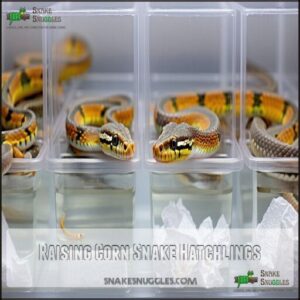This site is supported by our readers. We may earn a commission, at no cost to you, if you purchase through links.
 If you’re planning on breeding corn snakes, you’ll need more than just passion—you’ll need precision.
If you’re planning on breeding corn snakes, you’ll need more than just passion—you’ll need precision.
Start by making certain your snakes are healthy, sexually mature (typically 2-3 years old), and at prime weight.
You’ll want to simulate their natural breeding cycle through brumation, gradually cooling them down to trigger reproductive instincts.
Introduce male and female during breeding season, watching for successful mating signs.
Provide a suitable egg-laying environment with proper temperature and humidity for gravid females.
Carefully monitor egg development in an incubator, maintaining consistent conditions.
Successful breeding requires patience, careful observation, and a deep understanding of these fascinating reptiles’ reproductive needs.
Table Of Contents
- Key Takeaways
- Corn Snake Breeding Basics
- Preparing Corn Snakes for Breeding Season
- Brumation Process for Corn Snake Breeding
- Mating Corn Snakes: Techniques and Considerations
- Caring for Gravid Corn Snakes
- Incubating Corn Snake Eggs
- Raising Corn Snake Hatchlings
- Frequently Asked Questions (FAQs)
- What is the Best Way to Sex a Corn Snake?
- How Often Should I Feed Adult Corn Snakes?
- Are There Any Special Incubation Requirements for Corn Snake Eggs?
- How Do I Know When Corn Snakes Are Ready to Mate?
- How easy is it to breed corn snakes?
- How old do corn snakes need to be to breed?
- Can you breed corn snakes without brumation?
- Can you keep a male and female corn snakes together?
- Can corn snakes be bred year-round?
- What are common breeding challenges for corn snakes?
- Conclusion
Key Takeaways
- You’ll need to master brumation by gradually cooling your corn snakes from December to February, which triggers their natural reproductive cycle and resets their hormonal systems.
- Successful breeding depends on precise health monitoring, including checking sexual maturity (typically 2-3 years old), maintaining optimal body weight, and conducting thorough pre-breeding veterinary screenings.
- You’ll have to create specialized breeding environments with carefully controlled temperature gradients (80-85°F), humidity levels (60-70%), and specific substrate conditions to support mating and egg development.
- Your hatchling care is critical – you’ll need to set up individual enclosures, provide appropriately sized prey, handle them gently, monitor their growth, and prevent potential cannibalism by separating young snakes.
Corn Snake Breeding Basics
If you’re ready to commence on the exciting journey of breeding corn snakes, you’ll need to understand some critical fundamentals that separate successful breeders from novices.
Your breeding success hinges on knowing precise details about snake maturity, health requirements, and the intricate reproductive cycle that transforms your serpentine companions into proud parents.
Sexual Maturity and Size Requirements
When planning corn snake breeding, consider sexual maturity isn’t just about age.
Minimum size and breeding weight are key markers for reproductive readiness.
Most corn snakes reach sexual maturity around 18-24 months, but growth rate and sexual dimorphism play significant roles.
Make sure your snakes are healthy, well-fed, and meet size requirements before introducing potential mates.
Ideal Breeding Age for Corn Snakes
Your breeding blueprint for corn snakes starts with patience and precision.
Wait until your slithery friends hit the three-year milestone before matchmaking.
Sexual maturity isn’t just about age—it’s about holistic readiness.
Maturity signs to watch:
- Robust body weight
- Consistent healthy shedding
- Energetic movement patterns
- Strong appetite
- Minimal stress responses
Timing is everything in corn snake breeding success.
Breeding Season in Captivity
When your corn snakes hit 18-24 months, you can master their breeding season through smart environmental conditioning.
Temperature and light cycles become your secret weapons in triggering mating behaviors.
By mimicking natural seasonal changes, you’ll orchestrate the perfect breeding window.
Patience and precise photoperiod manipulation are your keys to success in captive breeding challenges.
Genetic Considerations for Breeding Pairs
Want to breed stunning corn snake morphs?
Success starts with smart genetic matchmaking! Here’s how to choose breeding pairs wisely:
- Map out hidden recessive genes that can create jaw-dropping color variations
- Avoid genetic landmines by preventing close-relative pairings
- Understand trait inheritance to predict potential offspring patterns
Your genetic strategy determines the magic of future snake generations!
Health Assessment Before Breeding
Your snake’s health isn’t just a checkbox—it’s your breeding program’s foundation.
Before matchmaking your reptilian friends, schedule a thorough veterinary screening.
Focus on genetic testing to prevent inherited issues and conduct thorough parasite detection through fecal analysis.
Check reproductive organ health carefully, ensuring both snakes are prime candidates for breeding.
Implement strict quarantine protocols to prevent potential disease transmission.
Screen for nutritional deficiencies that might compromise fertility.
A detailed health assessment isn’t just smart—it’s your roadmap to successful corn snake breeding.
Your future hatchlings’ lifeblood depends on these critical pre-breeding evaluations.
Equipment Needed for Breeding Corn Snakes
If you’re serious about corn snake reproduction, your toolkit matters.
Prepare spacious breeding enclosures (at least 30-40 gallons) with a reliable thermogradient.
Invest in high-quality heating elements like ceramic heat emitters or heat mats with adjustable thermostats. Add humidity-controlling substrate, precision hygrometers, and soft-lined nesting boxes.
Consistent temperatures are key, so consider a dedicated snake incubator. Professional-grade incubators guarantee prime egg development, transforming your breeding setup from amateur to expert level.
Common Challenges in Corn Snake Breeding
After gathering your breeding gear, you’ll discover corn snake reproduction isn’t for the faint of heart.
Breeding challenges like egg binding, genetic defects, and hatchling mortality can quickly derail your plans.
Watch for male aggression, potential inbreeding concerns, and cannibalistic tendencies among young snakes.
Husbandry mistakes can lead to birth defects or total breeding failure.
Pro breeders know these snake breeding challenges require constant vigilance and expert-level management.
Preparing Corn Snakes for Breeding Season
If you’re ready to breed corn snakes, you’ll need to prepare your slithery friends carefully for their reproductive season by focusing on nutrition, environment, and health.
Your success depends on understanding key factors like increasing feeding frequency, monitoring body condition, and creating the right breeding setup that mimics their natural seasonal changes.
Increasing Feeding Frequency and Nutrition
When preparing for corn snake breeding season, you’ll need to supercharge your snakes’ nutrition game.
Your pre-mating diet strategy should focus on building robust health and energy reserves.
- Increase feeding frequency to 2-3 times weekly
- Choose varied, high-protein prey sizes
- Gut-load feeder rodents for maximum nutrition
- Monitor individual snake’s weight and condition
Healthy meals mean healthier breeding potential.
Adjusting Environmental Conditions
After ramping up your corn snake’s nutrition, it’s time to craft the perfect breeding environment.
Your success hinges on mimicking nature’s rhythm through precise environmental adjustments. Temperature gradients, humidity control, and lighting schedules become your secret weapons in corn snake breeding.
- Create a seasonal simulation that tricks your snakes into breeding mode
- Design enclosures that provide comfort and encourage reproductive behaviors
- Master the art of environmental manipulation to boost breeding success
Transform your terrarium into a love nest by gradually adjusting conditions. Slowly shift temperatures, tweak lighting cycles, and watch as your corn snakes respond to these carefully orchestrated changes.
It’s also important to maintain proper ventilation for peak health.
Monitoring Weight and Body Condition
Because successful corn snake breeding hinges on precise health metrics, you’ll want to master weight and body condition tracking.
Use a digital scale to monitor weight fluctuations weekly, creating a detailed feeding chart that reveals subtle changes.
Check your snake’s body scoring carefully – they should look well-rounded with good muscle mass, showing healthy shedding patterns without excess fat.
Hydration levels matter too, so observe their overall condition carefully.
Separation of Males and Females
Your corn snake breeding success hinges on strategic separation.
During mating season, house males and females in distinct enclosures to manage breeding frequency and minimize stress.
This post-mating separation prevents potential aggression, allows female recovery, and helps control the breeding cycle’s impact.
Careful reintroduction is key, as heightened hormones can trigger unexpected territorial behaviors.
Pre-breeding Health Checks
After splitting up your slithery sweethearts, it’s time for a health reality check.
Your snake’s breeding success hinges on their wellness, so don’t skip these pre-breeding protocols:
- Book a reptile vet exam for thorough Parasite Screening
- Conduct thorough Body Condition and Hydration Status assessments
- Review Genetic Screening and Quarantine Protocol documentation
Pro breeders know: healthy snakes make happy babies!
Setting Up Breeding Enclosures
When designing breeding enclosures for corn snakes, think of yourself as a matchmaker creating the perfect romantic retreat. Your goal is to craft an environment that signals safety, comfort, and breeding potential.
| Feature | Specification | Breeding Advantage |
|---|---|---|
| Enclosure Size | 20-30 gallons | Provides ample space for courtship |
| Substrate | 2-3 inches deep | Mimics natural nesting conditions |
| Temperature Gradient | 75-85°F | Supports reproductive behaviors |
| Hiding Spots | Multiple options | Reduces stress, increases comfort |
| Humidity Control | 50-60% | Promotes healthy breeding cycles |
Focus on creating a sanctuary that meets your snakes’ biological needs.
Choose a spacious terrarium with multiple ventilation holes and a reliable thermostat to maintain precise temperature control.
Your substrate choice matters—aspen shavings or coconut husk create an ideal environment for potential egg-laying.
Selecting the right breeding enclosure substrate is key for successful breeding.
Strategically place hiding spots to give your snakes a sense of security during their intimate breeding dance.
Brumation Process for Corn Snake Breeding
If you’re serious about breeding corn snakes, you’ll need to master the critical brumation process, which simulates winter conditions to trigger their reproductive cycle.
By carefully lowering temperatures and reducing light exposure from December to February, you’ll help your snakes prepare for a successful mating season.
And maximize your chances of producing healthy offspring.
Importance of Brumation in Breeding Cycle
You’ve prepped your corn snakes for breeding – now it’s time to master brumation, nature’s fertility reset button. This strategic cooling process isn’t just a winter nap; it’s a hormonal trigger that jumpstarts reproduction.
- Mimics wild seasonal shifts
- Preserves genetic health
- Regulates snake breeding cycles
- Builds critical fat reserves
- Enhances reproductive potential
Brumation transforms your snakes from passive to passionate, awakening dormant reproductive systems and setting the stage for successful corn snake breeding. Captive snakes also benefit from simulated winter conditions, improving their overall health.
Gradual Temperature and Light Reduction
You’re about to orchestrate nature’s rhythm for your corn snakes.
When preparing for brumation, softly reduce light exposure and lower temperatures each week.
This gradual photoperiod adjustment mimics winter’s approach, signaling your snakes to enter dormancy.
Your careful monitoring prevents fat depletion and keeps them healthy during this cool period, setting the stage for successful breeding.
Optimal Brumation Duration and Conditions
When you’re ready to cool down your corn snake for breeding, aim for a brumation period between 60-75 days.
Keep temperatures steady between 45-65°F, creating a winter wonderland that mimics their natural habitat.
Slight temperature variations won’t derail your plans—they can actually help!
Maintain low humidity around 50-60% and keep the room dark.
Pro corn snake breeding tips suggest this controlled cooling period triggers reproductive readiness.
Patience is your best friend during this delicate process.
Monitoring Snake Health During Brumation
During brumation, your corn snake’s health requires precise monitoring.
Watch for these critical signs:
- Track weight loss (max 10-15%)
- Monitor unusual shedding patterns
- Check for stress behaviors
- Observe subtle health changes
Your snake’s winter slumber isn’t a time to relax your vigilance. While metabolism slows, potential health issues can still emerge.
A keen eye and careful observation will help guarantee. your snake emerges healthy and ready for breeding season.
Proper Hydration During Cooling Period
After methodically managing your corn snake’s cool period, hydration becomes your next mission. Water isn’t just survival; it’s strategic snake maintenance.
- Keep a wide, shallow water dish accessible
- Monitor humidity between 40-60%
- Check for dehydration warning signs
- Refresh water every 2-3 days
Snake hydration during brumation demands precision.
Sunken eyes or wrinkled skin signal trouble, so watch closely.
Your goal? Maintaining moisture without waterlogging your slithery friend’s delicate system.
Post-brumation Care and Reintroduction to Normal Conditions
When spring whispers its first hints, gently awaken your corn snakes from their winter slumber.
Gradually increase enclosure temperatures and lighting over two weeks, mimicking natural seasonal shifts.
Monitor their hydration carefully, offering small water amounts during this delicate shift.
Reintroduce feeding with smaller meals, watching for signs of renewed appetite.
The post-brumation shed signals they’re ready for the upcoming breeding season, marking a critical moment in their health and reproductive cycle.
Keep temperatures stable and observations sharp.
Mating Corn Snakes: Techniques and Considerations
When you’re ready to breed corn snakes, understanding their mating process is key for success.
You’ll need to master the art of introducing males and females, recognizing receptive behaviors, and creating the right conditions for successful reproduction.
Introducing Male and Female Corn Snakes
After emerging from their winter slumber, introducing corn snakes for breeding requires strategic finesse.
Snake lovers, master the delicate dance of corn snake courtship with patience, precision, and profound respect for nature’s reproductive rhythms.
Your mating mission begins in a neutral enclosure designed to minimize territorial tensions:
- Select a spacious, unfamiliar habitat
- Schedule introductions during twilight hours
- Watch for initial reactions and body language
- Prepare a safe separation method
Careful monitoring guarantees successful snake courtship.
Signs of Receptiveness in Female Snakes
After sizing up potential mates, female corn snakes broadcast their readiness through unmistakable pheromone signals and body language.
Watch for her distinctive tail-twitching and subtle head-bobbing—her snake version of a mating dance.
An open-mouth gesture or lifted tail screams "I’m ready!"
These receptivity cues help male corn snakes recognize her fertile state and initiate courtship, ensuring successful breeding opportunities.
Male Courtship Behaviors and Mating Process
Male corn snakes transform into passionate suitors during breeding season.
Their intricate courtship dance involves strategic hemipenes probing and pheromone recognition.
Watch as males perform gentle body alignments, nudging females with calculated movements.
These serpentine Don Juans flick their tongues, gathering chemical signals that indicate female receptiveness. Cloacal alignment becomes their ultimate goal, showcasing nature’s precise mating choreography with calculated precision and instinctive grace.
Duration and Frequency of Mating Sessions
Snake matchmakers, listen up!
During corn snake breeding, aim for multiple lock sessions spanning a week to boost fertility.
Each mating typically runs 15-30 minutes, but don’t be shocked if passionate partners extend their rendezvous.
Maximize your chances by introducing males and females strategically, allowing several opportunities for successful copulation without overwhelming your scaled sweethearts.
Some species even engage in elaborate snake courtship displays to attract a mate.
Monitoring for Successful Copulation
Now that your corn snakes have started their mating dance, you’ll want to confirm successful copulation by watching their snake love language.
Here’s what signals a promising mating session:
- Physical connection lasting 10-20 minutes
- Female’s receptive body positioning
- Male’s rhythmic tail movements
- Visible cloacal alignment and "lock" formation
Breeding experts know snake copulation isn’t just about chance—it’s a carefully observed process.
Watch for subtle behavioral cues that indicate your corn snakes are doing the reproductive rumba.
Patience and keen observation are your best tools in confirming a successful mating.
Separating Snakes After Mating
After successful snake mating, quick separation prevents potential drama. Aggressive males can stress females, disrupting their recovery process.
Here’s a quick behavioral guide:
| Behavior | Male | Female | Action |
|---|---|---|---|
| Post-Mating | Territorial | Egg Preparation | Separate Immediately |
| Hormonal State | High Aggression | Reproductive Focus | Provide Calm Space |
| Feeding Interest | Low | Increased | Monitor Nutrition |
| Recovery Needs | Minimal | Significant | Individualized Care |
Your breeding pair needs space to thrive.
Multiple Mating Strategies for Increased Fertility
After carefully orchestrating the mating separation, boost your fertility game with strategic sequential mating techniques.
Extended pairing offers remarkable advantages in snake breeding success.
- Rotate males every few days to prevent exhaustion
- Allow 2-3 days between mating attempts for recovery
- Introduce males to females 3-5 times per breeding season
- Monitor female receptivity through behavioral changes
Sperm competition and male rotation can greatly increase your chances of producing genetically diverse corn snake offspring.
Caring for Gravid Corn Snakes
You’re about to commence on the critical phase of corn snake breeding: caring for a gravid female, which requires keen observation and specialized care.
When your female corn snake is pregnant, she’ll need extra attention to her nutrition, environment, and overall health to guarantee a successful egg-laying process.
Signs of Pregnancy in Female Corn Snakes
After your mating dance concludes, watch your female closely for gravid signals.
Her body will transform, revealing pregnancy through dramatic weight gain and abdominal swelling.
You’ll notice behavioral changes like increased appetite and restless nesting instincts. A pre-laying shed hints she’s preparing for motherhood.
Her rounded body becomes a living demonstration to the miracle of snake reproduction – she’s not just eating for two, but potentially dozens!
Nutritional Requirements for Gravid Females
When your female snake shows those telltale pregnancy signs, her nutritional needs skyrocket!
Boost her calcium intake through gut-loaded prey or powdered supplements to support strong egg development.
Vitamin D3 becomes your secret weapon for prime calcium absorption.
Increase feeding frequency with smaller, nutrient-dense meals every 3-4 days.
Monitor her weight carefully—you’re nurturing life, not creating a serpentine sumo wrestler!
Providing Optimal Environmental Conditions
Architectural precision matters when crafting the ideal environment for your gravid corn snake. Your snake’s sanctuary demands scrupulous attention to environmental conditions that support her delicate reproductive journey.
- Maintain a steady temperature gradient between 80-85°F
- Keep humidity levels consistent at 60-70%
- Provide a well-ventilated enclosure with soft aspen substrate
Create a thermal haven with a basking spot reaching 88-90°F, your snake feels secure and comfortable during this critical breeding phase.
Pre-laying Shed and Behavioral Changes
When your corn snake starts showing those unmistakable pre-laying signals, you’ll know something exciting’s about to happen!
Watch for these key indicators of an impending egg-laying event:
- The snake becomes a drama queen
- Her shed looks like a foggy crystal ball
- Movement gets wiggly and unpredictable
- Appetite takes a nosedive
- Her body language screams "I’m about to be a momma!"
These behavioral shifts mark the countdown to your gravid snake’s big moment.
Her prenatal shed signals that ovulation is complete and egg-laying is just around the corner.
Setting Up Suitable Egg-Laying Boxes
As your corn snake approaches her big moment, it’s time to craft the perfect nesting sanctuary.
Your egg-laying box should be slightly larger than her coiled form, with strategic ventilation that whispers "breathe easy" rather than roars.
Line the bottom with sphagnum moss—your moisture maestro—keeping it damp but not drowning. Think tropical resort, not rainforest swamp.
A critical aspect involves humidity levels between 40-60% to confirm proper egg development.
Location matters: choose a quiet, stable spot where she’ll feel secure depositing her precious corn snake eggs.
Monitoring for Egg-Laying Process
After preparing your nesting box, you’ll soon witness the egg-laying spectacle of your gravid corn snake.
Pro breeders know the signs of impending clutch production:
- Frequent, restless box exploration
- Rhythmic body stretching and coiling
- Subtle muscular contractions near midsection
- Noticeable swelling around cloaca region
Watch closely as your snake navigates her egg-laying journey. Her nesting behavior reveals intricate details about clutch size and egg viability.
Each movement signals the delicate process of bringing new life into the world – a demonstration to nature’s remarkable reproductive design.
Post-laying Care for Female Corn Snakes
Every exhausted snake mom needs a recovery plan after egg-laying.
Your gravid corn snake requires strategic hydration strategies and careful weight replenishment.
Offer fresh water daily and feed small meals every 5-7 days.
Veterinary checkups can help monitor her post-laying shed and overall health.
Minimize handling to reduce stress during her recuperation environment.
Watch for weight loss and make certain she’s regaining strength gradually.
Calcium supplementation might help her bounce back faster.
Incubating Corn Snake Eggs
When you’re ready to incubate your corn snake eggs, you’ll need to create the perfect microclimate to guarantee healthy development.
Egg incubation is a delicate dance of temperature, humidity, and pure snake magic.
Mastering the right temperature, humidity, and substrate will transform your eggs from fragile beginnings into squirming hatchlings that’ll make any breeder proud.
Proper Handling and Collection of Eggs
Your corn snake’s egg bundle demands delicate TLC during collection and handling.
Each fragile orb carries the potential of future slithery generations, so precision matters.
- Mark egg orientation with a soft pencil dot
- Use featherlight touches when moving eggs
- Check for uniform, healthy shell appearance
- Minimize handling time to prevent damage
Transfer carefully, preserving their original positioning.
Treat these reproductive treasures like scientific specimens—with respect, care, and thorough attention to detail.
Incubation Substrate and Container Selection
So you’ve successfully collected your corn snake eggs – now let’s nail the perfect incubation setup!
Here’s your game plan:
- Pick Your Medium: Vermiculite vs perlite are top contenders
- Moisture Magic: Damp substrate wins, not soaking wet
- Container Criteria: Sterile, ventilated, secure
- Egg Handling: Gentle placement preserves hatching success
Your incubator’s about to become a snake nursery!
Many breeders source their corn snake vermiculite online.
Optimal Temperature and Humidity Levels
Get your egg incubation spot on with precise temperature and humidity control!
Aim for a steady 27-30°C (80-86°F), maintaining humidity between 75-85%.
Think of it like a climate-controlled nursery—too dry, and eggs shrivel; too wet, and mold takes over.
Maintaining proper humidity is important for healthy egg development.
Your monitoring equipment is key to creating the perfect thermogradient for those precious corn snake eggs.
Egg Turning and Positioning During Incubation
Imagine your corn snake eggs as delicate time capsules requiring gentle care.
Rotate them carefully 2-3 times daily, maintaining consistent orientation.
Your soft touch prevents embryo membrane damage and guarantees even heat distribution.
Position eggs carefully in vermiculite or similar substrate, keeping them slightly separated and never touching container walls.
These precise movements boost your hatchlings’ survival odds. Rotate them carefully.
Monitoring Egg Development and Viability
When you’re monitoring corn snake egg development, candling becomes your detective tool.
Look for vein networks spreading like delicate spider webs inside healthy eggs.
Track weight changes and watch for consistent humidity levels.
Discolored, dented, or moldy eggs signal trouble—remove them quickly to protect viable clutches.
Precise temperature and careful observation boost your hatch rates dramatically.
Preparing for Egg Hatching
After carefully tracking your corn snake eggs’ development, you’re now primed for the most exciting phase: hatching.
Prepare a systematic approach with these key steps:
- Maintain precise humidity levels
- Keep eggs undisturbed in their original position
- Ready your emergency hatching assistance kit
Your snake hatchling enclosures should be prepped, ensuring a safe, controlled environment for these delicate new lives to emerge.
Dealing With Infertile or Dead Eggs
Not all corn snake eggs will hatch.
Learn to spot "slugs" through careful candling techniques – these infertile eggs look different from viable ones.
Remove them quickly to prevent mold and bacterial growth that could contaminate your entire incubation batch.
Proper disposal and maintaining clean incubation conditions are key to protecting healthy eggs and ensuring successful corn snake breeding.
Raising Corn Snake Hatchlings
You’ve just witnessed your corn snake hatchlings emerge, and now it’s time to set them up for success in their new lives.
Proper care during these first key weeks involves creating safe, individual enclosures with precise temperature gradients, providing appropriately sized prey, and monitoring their health to guarantee these tiny serpents thrive.
Assisting Hatchlings During Emergence
After weeks of egg incubation, your snake hatchlings are ready to emerge!
Here’s how to support their safe emergence like a pro:
- Check eggs for natural pip marks and slight cracks
- Maintain high humidity to prevent stuck hatchlings
- Never forcibly remove snakes from eggs
- Allow each hatchling to exit independently within 24-48 hours
Let these tiny serpents navigate their first big adventure with minimal intervention and maximum care.
Setting Up Hatchling Enclosures
Creating a cozy habitat for your baby corn snakes means selecting the right enclosure—think of it as their first studio apartment.
Choose a small, secure space with proper ventilation and a temperature gradient.
Line the bottom with safe substrate like paper towels or reptile carpet.
Include a hide, shallow water dish, and gentle heating to keep your tiny serpents comfortable and secure.
First Feeding and Nutrition for Neonates
Neonate nutrition is the heartbeat of successful hatchling care.
Your tiny serpent friends need precise feeding strategies to thrive.
Here’s how to nail their first meals:
- Match pinky size to snake’s body width
- Feed every 5-7 days with gut-loaded prey
- Supplement with essential vitamins
- Monitor hydration during shedding cycles
Mastering these techniques confirms your hatchlings grow strong and healthy.
Handling and Socializing Young Corn Snakes
Gently supporting young corn snake hatchlings helps shape their temperament during first handling sessions.
Move slowly and confidently, letting them explore your hands without sudden movements.
Minimize stress by creating a calm environment with soft background noise and consistent, gentle interactions. Prioritize short, positive handling experiences to build trust and reduce potential bite incidents.
Socialization benefits both snake and handler.
Growth Monitoring and Health Checks
After handling your baby corn snakes, start their health tracking journey.
Monitor weight carefully on precise growth charts, watching for steady increases.
Check shedding frequency as a key health indicator, making certain of clean, complete skin removal.
Perform regular physical examinations, looking for signs of parasites or unusual behavior changes.
Stay vigilant about hydration levels and overall snake breeding health.
Separating Hatchlings to Prevent Cannibalism
Why do baby corn snakes turn into tiny predators?
Preventing hatchling cannibalism demands strategic intervention. Separate each snake immediately to minimize aggression and secure survival.
- Observe subtle signs of potential attacks
- Create individualized microhabitats
- Implement precise feeding schedules
- Monitor interactions with hawk-like vigilance
Size disparities and hunger drive these pint-sized reptilian troublemakers toward sibling snacking. Your careful management prevents these prehistoric survival instincts from turning the nursery into a snake-eat-snake scenario.
Preparing Hatchlings for Sale or Future Breeding
Master snake breeders know preparing hatchlings for future homes requires precision and care.
Check out this essential roadmap to success:
| Stage | Focus | Key Outcome |
|---|---|---|
| Weeks 1-4 | Feeding Schedule | Consistent Growth |
| Weeks 5-8 | Genetic Lineage | Trait Identification |
| Weeks 9-12 | Temperament Assessment | Buyer Confidence |
| Weeks 13-16 | Health Screening | Quality Assurance |
| Weeks 17-20 | Market Preparation | Sale Readiness |
Carefully document each hatchling’s development, guaranteeing prime health and marketability for future snake enthusiasts.
Frequently Asked Questions (FAQs)
What is the Best Way to Sex a Corn Snake?
You’ll want to probe the tail base or "pop" the hemipenes to determine sex.
A veterinarian or experienced reptile handler can help you safely identify your corn snake’s gender without risking injury.
How Often Should I Feed Adult Corn Snakes?
In the snake world, feast or famine isn’t a joke!
Adult corn snakes typically thrive on one appropriately-sized mouse every 10-14 days.
Adjust based on snake’s size, age, metabolism, and seasonal changes for peak health.
Are There Any Special Incubation Requirements for Corn Snake Eggs?
You’ll need a consistent 78-84°F temperature and 70-90% humidity during egg incubation.
Use vermiculite or peat moss as the medium, place eggs carefully without rotating.
And maintain stable environmental conditions for successful hatching.
How Do I Know When Corn Snakes Are Ready to Mate?
You’ll know corn snakes are ready to mate when males shed and become active.
Females show posterior swelling, and both display increased interaction during late winter or early spring breeding season.
How easy is it to breed corn snakes?
Breeding corn snakes isn’t a walk in the park, but it’s doable with patience.
You’ll need to master brumation, temperature control, and understanding snake behavior.
Proper preparation and knowledge make the process manageable for dedicated reptile enthusiasts.
How old do corn snakes need to be to breed?
Think breeding corn snakes is a walk in the park?
Hold your horses!
You’ll want sexually mature females (2-3 years old) and males (5-2 years), weighing at least 300 grams to guarantee successful, healthy reproduction.
Can you breed corn snakes without brumation?
Without brumation, corn snake breeding becomes challenging.
You’ll likely see reduced fertility and lower success rates.
Mimicking natural seasonal temperature cycles is key for triggering their reproductive instincts and ensuring healthy mating outcomes.
Can you keep a male and female corn snakes together?
Despite their seeming compatibility, keeping male and female corn snakes together year-round isn’t recommended.
They’ll mate constantly, exhausting and potentially injuring each other.
Separate them except during intentional, supervised breeding periods to guarantee their health.
Can corn snakes be bred year-round?
No, you can’t breed corn snakes year-round.
They require a specific brumation period from December to February, which triggers their natural reproductive cycle.
Successful breeding depends on mimicking seasonal temperature and light changes. Brumation period from December to February.
What are common breeding challenges for corn snakes?
When Mother Nature throws curveballs, corn snake breeders face hurdles like egg fertility issues, temperature sensitivity, and potential health risks.
Careful monitoring, precise environmental control, and veterinary support can help navigate these reproductive challenges successfully.
Conclusion
Like gardeners nurturing delicate seedlings, you’ll cultivate successful corn snake breeding through patience and precision.
Your journey into breeding corn snakes demands careful attention to detail, from brumation to hatchling care.
By mastering the intricate reproductive cycles and providing choice conditions, you’ll transform your passion into a rewarding experience.
Remember, successful breeding isn’t just about producing offspring—it’s about understanding and respecting these remarkable reptiles’ complex needs.
- https://www.icr.org/article/snake-hybridization-intrabaraminic-diversity/
- https://arav.org/
- https://binkybunny.com/forums/topic/my-youngest-rabbit-started-to-eat-her-aspen-shavings-and-doesnt-like-to-use-litterbox-with-itae/
- https://oaklandnaturalareas.com/2022/09/08/bogs-the-peculiar-land-of-sphagnum-moss/
- https://reptile.guide/corn-snake-care/

